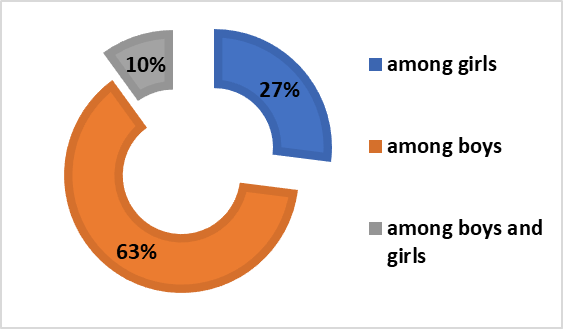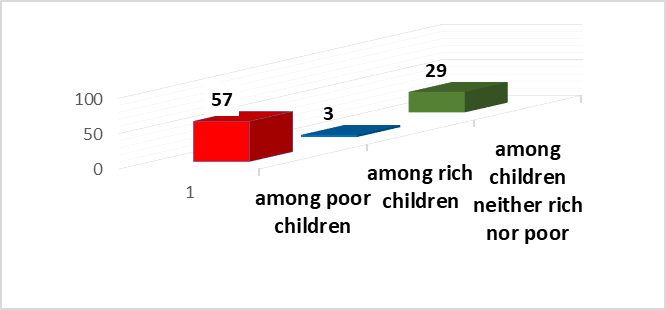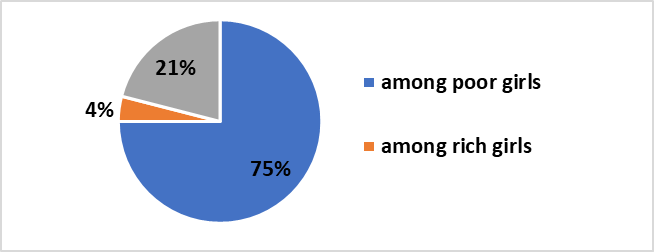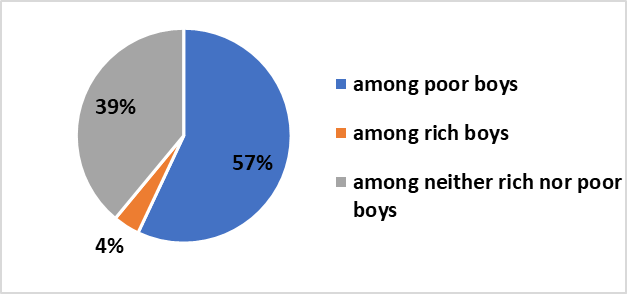Abstract
In this paper we will present the results of a research that addresses a topical issue, which is quite frequent, especially in Romanian rural schools, namely the poverty and the aggressive behaviour of the pupils. Aggressiveness as a phenomenon seems to grow and manifests itself more and more often in the school environment among pupils coming from unstable family environments where communication and family relationships are in a crisis situation. This issue is carefully monitored and presented in the media as well. The investigation was conducted in a rural school in Sibiu County and represents a preliminary study of the need’s analysis of a project that we are currently implementing and aims at: training teachers from disadvantaged schools for inclusive education, preventing and reducing of the phenomenon of school dropout, reducing aggressiveness, increasing student returns. We will present a concrete investigation into the phenomenon of violence at the level of a gymnasium school from a rural area. This research aims to look at the phenomenon of violence in school from the observational perspective on the one hand and from the ameliorative perspective on the other hand. It will try to offer (following the research results) a series of psycho-pedagogical assistance (in the form of individual and group counselling programs for students, teachers and parents).
Keywords: Povertyaggressive behaviourrural environmentintervention program
Introduction
The magnitude and consequences of aggressiveness phenomena of adolescents in schools have become increasingly intense and young people are increasingly victims of violent acts.
The family environment is the most important source of student aggression. Many students with an aggressive profile come from disorganized families. They have experienced the divorce of their parents and live in single-parent families. The family's balance is also altered by the lack of jobs and by the unemployment that affects many parents. Parents are confronted with many material and psychological difficulties because they have the feeling of devaluation, of failure. Under these circumstances, they are no longer or maybe less available for their children. Against this backdrop, very serious family problems arise, which deeply affect pupils: intra-family violence, alcohol abuse, child abuse, negligence, plus major educational gaps: lack of dialogue, affection, lack of coherence in the requirements formulated against the child, the use of violent means of punishing the child.
Problem Statement
The aggressive, violent and antisocial social and family environment contributes greatly to the development of aggressive and violent, but also anti-social behaviour in. Families marked by poor, underprivileged social environments, where violence and delinquency become normal, completely distort the perception of these attitudes and behaviours, thus children value what they see that adults do or assimilate the negative acts in the absence of any alternative form of behaviour. In other words, they do what they see in their family and the environment they grew up in.
The responsible and earnest assumption of the school for educational guidance of pupils involves confronting teachers with the daily problems of aggressive behaviour of pupils, caused by concrete causes such as disorganized families, poverty, entourage, educational deficiencies, etc.
Following the research and identification of elements of the aggression phenomenon in schools, an intervention project was developed aiming to prevent and reduce the phenomenon of aggression and to achieve inclusive education (Vrăşmaş, 2001).
Awareness activities:
processing the Internal Regulation with emphasis on notions related to "discipline", "discipline deviation", "violence", "aggression";
counselling hours with the participation of pupils and their parents for the presentation and processing of cases of aggression in schools promoted by televisions.
Intervention activities:
developing a school-level project on combating aggression;
creating and producing of materials on the aggressiveness issue, with the title "A Safe School" (photos, compositions, role plays);
performing sports activities, paying special attention to students with aggressive potential, with their involvement in promoting fair play in sports;
involving pupils in managing crisis situations in school;
the participation of local authorities and the police agent to actions of presenting cases of aggressive behaviour present by media, that took place in schools, to raise awareness of the consequences of such acts and to prevent them from occurring.
Evaluation indicators:
Familiarization of students with the terms and themes regarding aggression in schools;
The degree of involvement of students in aggressive thematic activities;
Changes in attitude towards aggressive actions.
Research Questions
The poverty influences the aggressive behaviour of the pupils?
Which are the indicators of the state of the poverty?
Purpose of the Study
Molnar (1999), considers that "poverty is a disease of the society", which causes suffering to those who are under its influence and at the same time, disturbs through its manifestations the entire society, affecting the capacity of the social body to develop and the functioning of the economy.
In the author's view, there are two types of definitions of poverty, drawn from the perspective of the complexity of the concept, leading to different ways of measuring poverty:
the oldest and simplest definition is the one-dimensional one in which poverty is defined by the inadequacy or lack of material (financial) resources, mainly the income necessary to acquire and dispose of the goods and services indispensable to assure a minimum acceptable living standard. Poverty is measured in this case on the basis of a single indicator considered relevant for expressing a person / family's well-being: available income or consumption expenditure. We fully agree with those who think the definition is too narrow and appropriate rather to express the absence of economic or material welfare;
modern definitions treat poverty as a complex, multidimensional phenomenon, considering some aspects of living conditions that are insufficient or are not at all reflected by the synthetic indicators of income or expenditure. The scope of resources is wider, along with the material resources being included also the cultural and social ones involved in the overall satisfaction of the fundamental human needs. The state of poverty is appreciated by the ability of people to participate in society, to function as members of the society.
Compared to the first definition, we can say that in the second, there is not just one indicator, but more indicators of living standards (family incomes and heritage) are used; demographic characteristics (life expectancy at a certain age, infant mortality, loneliness) and lifestyle (consumption, household equipment, comfort, health expenses, training, holidays, concerts, delinquency).
We can say that poor people are the unemployed and people without jobs, as well as those who have nothing to eat, those who attend the canteens of the poor, generally those with a number of needs: the need for housing, food, clothing, labour integration, money, the need for socialization and social relations, food, the need for a status, cultural, family needs, "the need for a living goal" and the gaining of self-confidence.
Indicators of the state of the poverty
Lack of housing or shelter
Investigated subjects report that the lack of housing or the existence of a small dwelling the misery they live in, poor hygiene and health deficiencies. Lack of dwelling causes vagabondage or sheltering in sewers and in dilapidated or evacuated buildings due to site insecurity or wall instability. Thus, people who share these shortcomings are brought together, forming a marginal group of society and creating their own set of rules and norms.
Long-term unemployment
Unemployment is considered a problem in industrialized countries due to the fact that work is a structured element in the psychological composition of a person, the experience of unemployment often disfigures people. The impact of the new technology seems to be likely to further increase unemployment rates (Neculau & Ferreol, 1999). An unemployed person can be defined as an able to work person who cannot be accommodated due to the lack of available jobs corresponding to his or her training. As a consequence of unemployment, we can list: food deprivation, clothing, overcrowding of the dwelling, recreational and educational activities deprivation or social isolation.
The poor family status
The large family: in the given circumstances of a constant property facing the increasing number of family members, the issue of the rather limited resources has emerged. Children in poor families are the most affected and have high rates of school dropout and increased tendencies towards delinquency. Moreover, most of them have negative examples alongside them (negligent mother, alcoholic and violent father, careless neighbours, delinquent friends). Single-parent family: it is often unacceptable because of the limited possibilities it offers, which are insufficient to provide the necessary living resources, and which often involve children in activities with the purpose of gaining additional income (Batâr, 2004, p. 73). If children are forced to work to bring additional income to the family, they are exploited by employers and are very badly paid. The vast majority of these families are run by women, as the wife usually obtains custody of children after divorce or if she is not married.
Lack of income and living resources
The lack of a job is one of the causes of poverty and implies the lack of income. In general, most of the activities that are conducted regarding the policies to combat poverty are limited to the distribution of financial aid and do not address job creation aspects. Because of the lack of income and living resources, debts arise. However, there is a group of people who do not even want to have a job and are satisfied with the social aid and the children’s social aid (Neculau, 2003).
Unhealthy living conditions
Most of the times the living conditions of the poor are unhealthy. Even if the dwelling is owned or rented, due to lack of money it is not connected to water, electricity and gas sources. Negligence accentuates these shortcomings, and disorder and misery dominate these dwellings. Overcrowding directly contributes to the formation and maintenance of these conditions.
Very small expenses per family member for meeting one’s essential needs
In general, poor families have an income that, even if it is the unemployment or the social aid, it cannot cover the expenses necessary for a family: food, clothing, maintenance or schooling. Most times, there are only one salary in poor families, and the number of family members is high. Income is spent quickly, and after that, the family is left with no financial resources for long periods of time.
Low level of social participation
Very low incomes limit the social participation of poor families. Most poor children have never been to a cinema, a concert or a show. Marginalization contributes greatly to reducing the social participation of the poor. This indicator favours the emergence of other concerns that can contribute to negative socialization (Zamfir & Vlăsceanu, 2000).
Lack of parental models for exteriorizing the family values
Missing father or absent mother deprives the child from following certain patterns. The lack of one of the parents can cause major emotional deficiencies that often favour the emergence of delinquent tendencies. In other cases, the presence of a negative model can also produce confusing states in the affective plane. If parents consume alcohol or drugs, they smoke and commit antisocial acts, the child is socialized negatively. Negligence and educational defects cause the state of defence, such as anxiety, depression, aggression, detachment, isolation.
Research Methods
Research objectives
-
Identification of poor families whose children attend school;
-
Identifying children with high aggression which are attending school;
-
Analysis of the correlation between poverty and aggression.
Research Hypotheses
A Starting from the general hypothesis that the poverty affects aggression in the family and also in the school, the following specific hypotheses were formulated in the research:
Poverty affects aggression and negligence of parents towards children;
The more aggressive the family is, the greater the aggression of children becomes;
If children in the school are predominantly descended from poor families, then their behaviour is aggressive
Period and location of the investigation
The investigation took place between January and June 2017, at the Biertan Gymnasium School, Sibiu County.
Investigation population
The range of the population consisted of pupils aged between 9 and 15 years, and as a sample we chose the exhaustive sampling, the sample consisting of 60 pupils aged between 9 and 15 years, of which 32 are males and 28 females, a total of 10 female teachers, as well as a sample of 20 subjects – namely parents of pupils from Biertan, Sibiu County.
Research methodology
The conducted study is an exploratory one, in which the following the methods were used:
The method of statistical analysis of documents, where statistical analysis sheets were developed to investigate the income of families with the scope of identifying poor families and at the same time identifying students coming from these families.
The method of analysing of school documents for an investigation of children's results in learning and behaviour. We have used statistical analysis sheets for learning outcomes and pupil behaviour.
The observation method in order to see the frequency of aggressive actions along five randomly chosen days, depending on their form, as reflected in the pupils' behavioural observation sheets.
Questionnaire based on a questionnaire technique (questionnaire and interview guide). We mention that the tools used were standardized questionnaires for the 20 parents and the interview guide for the ten teachers. The way of implementation was that of individual self-administration.
It is worth mentioning that in terms of the analysis of the obtained results we also used simple methods of data processing, such as: counting, share of different characteristics, comparison, classification.
Investigation limitations
We would like to point out that through the elaborated questionnaire we have not been able to capture all aspects of violence at the level of the school unit concerned. Moreover, as the subject of the questionnaire is about investigating such a sensitive phenomenon as violence, given the excessive media coverage of some cases of violence in school, teachers' answers can be suspected by some distortions, and that needs to be considered whether we want to monitor this phenomenon at the level of each school unit.
Findings
In the following chapter we will present some relevant aspects of the research results. Regarding the frequency of aggression by sex, we can say that the following results have been obtained.

From this graph (Figure

From the graph above, (Figure

From the graph above (Figure

From the graph above (Figure
The results obtained help us outline a general picture of the phenomenon of aggression in school, a phenomenon that contributes to a great extent to poverty in rural areas. The factors that influence the aggressiveness of the students are very numerous, a large part of them have been presented in the indicators of the state of poverty. Starting from this reality, we can propose some intervention strategies that are aimed at increasing the quality of life and the educational act.
Intervention project to prevent and reduce aggressiveness in school
Following the research and identification of elements of the aggression phenomenon in schools, an intervention project was developed aiming to prevent and reduce the phenomenon of aggression and to achieve inclusive education (Vrăşmaş, 2001).
Awareness activities:
processing the Internal Regulation with emphasis on notions related to "discipline", "discipline deviation", "violence", "aggression";
counselling hours with the participation of pupils and their parents for the presentation and processing of cases of aggression in schools promoted by televisions.
Intervention activities:
developing a school-level project on combating aggression;
creating and producing of materials on the aggressiveness issue, with the title "A Safe School" (photos, compositions, role plays);
performing sports activities, paying special attention to students with aggressive potential, with their involvement in promoting fair play in sports;
involving pupils in managing crisis situations in school;
the participation of local authorities and the police agent to actions of presenting cases of aggressive behaviour present by media, that took place in schools, to raise awareness of the consequences of such acts and to prevent them from occurring.
Evaluation indicators:
Familiarization of students with the terms and themes regarding aggression in schools;
The degree of involvement of students in aggressive thematic activities;
Changes in attitude towards aggressive actions.
Conclusion
Aggressiveness as a phenomenon seems to grow and manifests itself more and more often in the school environment among pupils coming from unstable family environments where communication and family relationships are in a crisis situation. The generation-to-generation conflict is aggravating, and unfortunately children find refuge in violent games offered by unrestricted access to the Internet, television or other enthusiastic concerns that do not provide real and positive answers to the problems they face. There is a growing need for a school for parents that must be strongly anchored in reality (Telleri, 2003). Aggressiveness seems to be a problem induced by the influence of the society we live in, where interpersonal relationships are degraded, where family and community abandon their educational role, leaving it as the responsibility of the school, where the school no longer meets the challenges, and the Internet and television have become "modern educators". As this behaviour has become an important social concern, we consider that it is necessary to develop a program to prevent and combat aggression that will be implemented and run through the school
References
- Batâr, D. (2004). Familiaîn dinamica societăţii, [Family in the dynamics of society], Sibiu: Universităţii “Lucian Blaga” din Sibiu.
- Molnar, M. (1999).Sărăciaşiprotecţiasocială, [Poverty and social protection] Bucureşti: Fundaţiei România de Mâine”.
- Neculau, A., Ferreol, G. (1999). Aspectepsihosociale ale sărăciei, [Psychosocial Aspects of Poverty] Iaşi: Polirom.
- Neculau, A. (2003). Manual de psihologiesocială, [Psychological and Social Manual], Iaşi: Polirom.
- Telleri, F. (2003). Pedagogiafamiliei, [Family pedagogy ], Bucureşti: Didacticăşi: Pedagogică.
- Vrăşmaş, T. (2001). Învăţământulintegratşi/sauincluziv, [Integrated and / or inclusive education.] Bucureşti: Aramis.
- Zamfir, C., Vlăsceanu, L. (2000). Strategiiantisărăcieşidezvoltarecomunitară, [Anti-Fraud and Community Development Strategies], Bucureşti: Expert.
Copyright information

This work is licensed under a Creative Commons Attribution-NonCommercial-NoDerivatives 4.0 International License.
About this article
Publication Date
25 June 2019
Article Doi
eBook ISBN
978-1-80296-062-4
Publisher
Future Academy
Volume
63
Print ISBN (optional)
-
Edition Number
1st Edition
Pages
1-613
Subjects
Teacher, teacher training, teaching skills, teaching techniques, special education, children with special needs
Cite this article as:
Mara, D., & Hunyadi, D. (2019). The Influence Of Poverty On Aggressive Behaviour Of Adolescents. In V. Chis, & I. Albulescu (Eds.), Education, Reflection, Development – ERD 2018, vol 63. European Proceedings of Social and Behavioural Sciences (pp. 463-471). Future Academy. https://doi.org/10.15405/epsbs.2019.06.55

